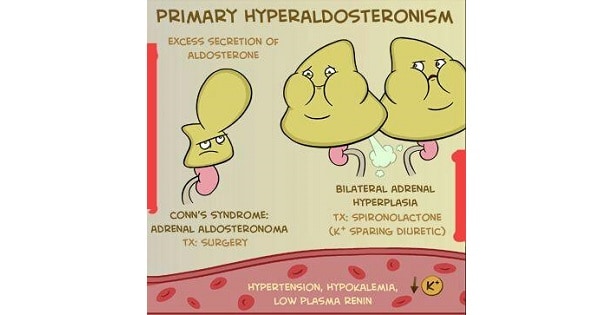Conn’s syndrome
CONN’S SYNDROME
- Conn’s syndrome or primary hyperaldosteronism is by hypertension due to hypersecretion of aldosterone.
Etiology-
- PHA with hypokalemia is unilateral adrenocortical adenoma (most frequent).
Clinical features-
- Females are more affected.
- Seen between 30- 50 years of age.
- Hypertension , hypokalemic alkalosis, hypernatremia
- Headache
- Muscle weakness (proximal myopathy), cramps.
- Neurological events.
- Polyuria, polydyspsia and nocturia
- Diastolic hypertension without oedema.

Investigations-
- Assessment of aldosterone to plasma rennin activity (ARR ratio)
- Conn’s adenomas are detected mostly
Treatment-
- Bilateral hyperplasma- spironolactone
- Antihypertensive drugs
- Unilateral laproscopic adrenolectomy
- Subtotal adrenal resection- Single Conn’s adenoma.
Exam Important
- Conn’s syndrome or primary hyperaldosteronism is by hypertension due to hypersecretion of aldosterone.
Etiology-
- PHA with hypokalemia is unilateral adrenocortical adenoma (most frequent).
Clinical features-
- Females are more affected.
- Seen between 30- 50 years of age.
- Hypertension , hypokalemic alkalosis, hypernatremia
- Headache
- Muscle weakness (proximal myopathy), cramps.
- Neurological events.
- Polyuria, polydyspsia and nocturia
- Diastolic hypertension without oedema.
Investigations-
- Assessment of aldosterone to plasma rennin activity (ARR ratio)
- Conn’s adenomas are detected mostly
Treatment-
- Bilateral hyperplasma- spironolactone
- Antihypertensive drugs
- Unilateral laproscopic adrenolectomy
- Subtotal adrenal resection- Single Conn’s adenoma.
Don’t Forget to Solve all the previous Year Question asked on Conn’s syndrome

